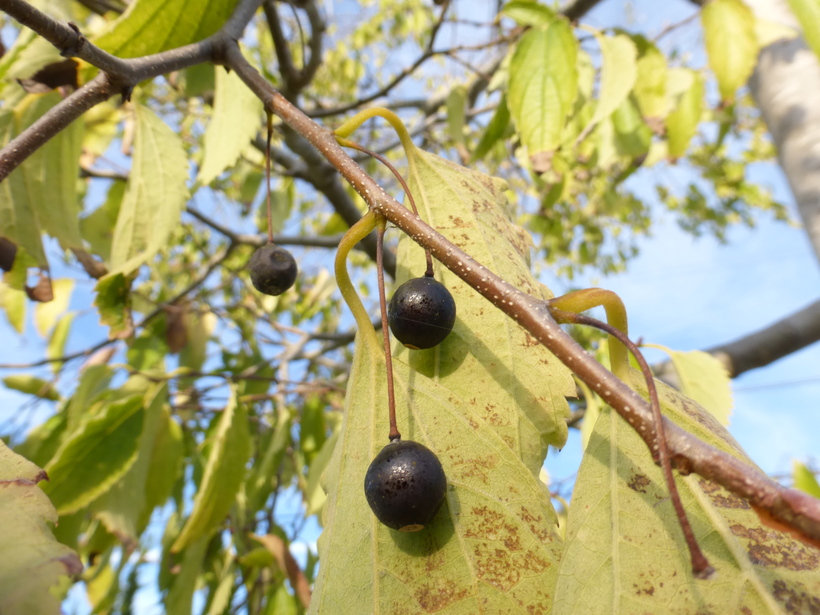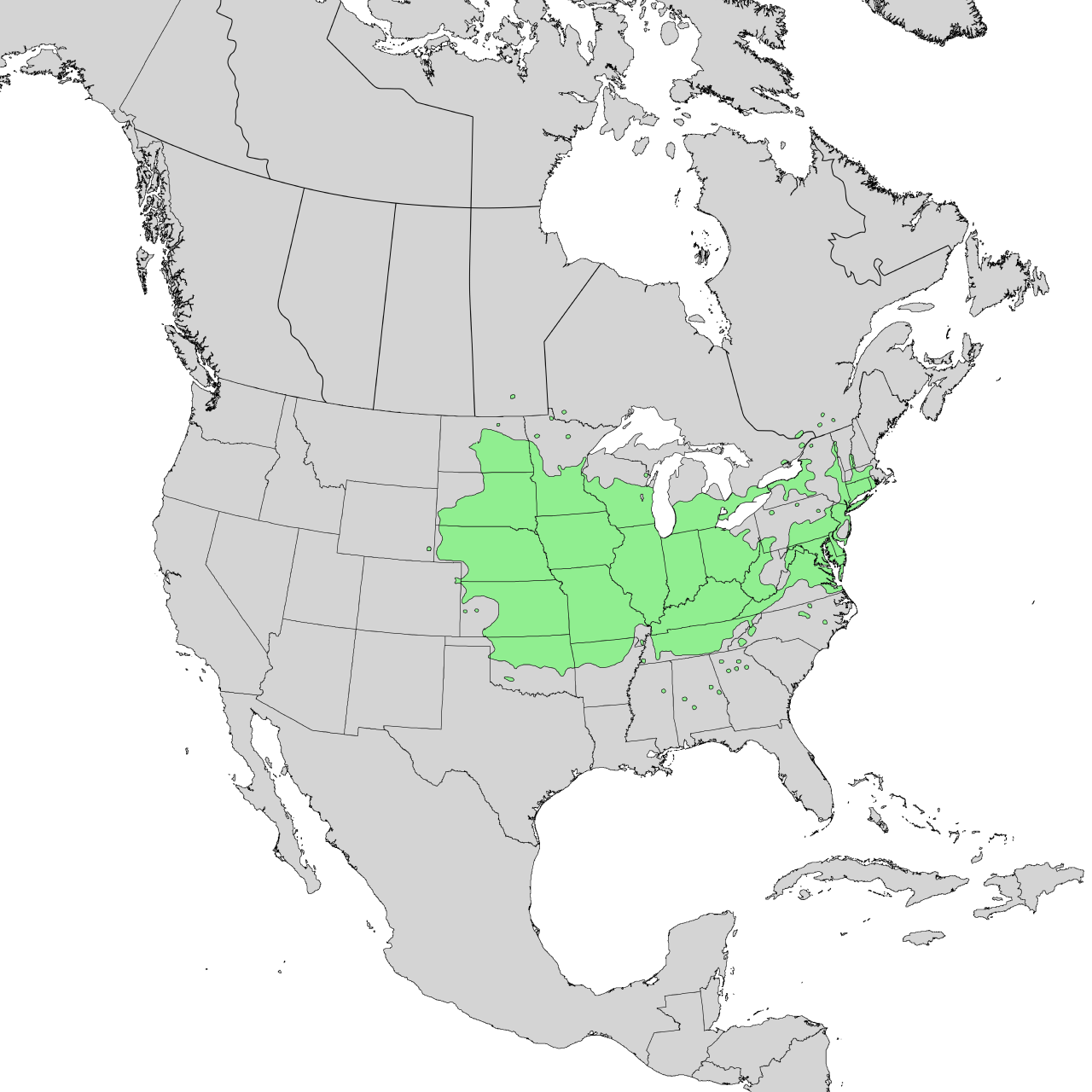Common Hackberry
Celtis occidentalis L.
Description
The hackberry tree is a member of the hemp family (Cannabaceae) but was previously assigned to the elm family (Ulmaceae). It is known by several common names including northern hackberry, nettle-tree, bastard elm, beaverwood and common hackberry 4,6 . It is a medium to large sized deciduous tree that thrives in full sun and a moist, rich environment with well-drained soil³. Typically, these trees will reach 40 to 60 feet, but it’s possible for them to grow up to 100 feet. Trunk diameter ranges from 1 to 4 feet. Hackberry trees have a cylindrical ovoid crown. Hackberry wood is heavy, soft, and weak, and there are deep, widespread roots. Bark is gray when mature and has corky ridges and a warty texture. Leaves are green, coarse-toothed, oblong-ovate with a rough in texture and are typically 2 to 5 in long. The leaf base is asymmetrical. In the fall, these leaves turn yellow. Hackberry produces small greenish-white, monoecious flowers in the spring – male flowers are clustered and female flowers are individual. Flowers are wind pollinated 7 . The fruit is a fleshy drupe, which when ripe become a deep purple color. The seeds are dispersed by birds. Hackberry is fairly tolerant to environmental conditions and can be easily transplanted 1,4 . The typical hackberry lifespan is between 150 to 200 years².

Corky bark of common hackberry. @ W. Longbottom 2020 (CC BY-NC), Maryland Plant Atlas10 .

Leaves of common hackberry. @ M. Etheridge* 2016, Maryland Plant Atlas10 .

Fruit of common hackberry. @ C. Akulova 2016 (CC-BY-NC 3.0), CalPhotos 11 .
Distribution
The native range of the hackberry is central and northeastern North America. It is quite common in the Midwest, specifically Missouri, and flourishes in environments like low woods along streams and dry upland slopes¹. Occasionally, they can be found in the Canadian provinces Manitoba, Ontario, and Quebec². In Maryland common hackberry is most frequent in the Piedmont and Eastern and Western Shore 10 .

Native distribution of common hackberry. USDA13
Wildlife Importance
The hackberry provides fruit for many small mammals and birds to eat, and these animals in turn disperse hackberry seeds. Additionally, shelter towards the ground is provided for rabbits and deer. Hackberry trees support many different species of butterfly including the Hackberry Emporer, Question Mark and Mourning Cloak butterflies, the American Snout, and the Tawny Emporer 4 . These butterflies seek shelter during the winter under loose bark and eat rotting fruit to survive the cold. They gravitate towards hackberry trees in the spring so that their young can feed on the leaves. Some of these species depend exclusively on hackberries 7 .
Economic Importance
Hackberry wood can be used for furniture, plywood, baskets, crates, and athletic equipment. The fruit is edible and can be made into jellies and preserves or spices if dried although not commonly commercially available 3,4 . Foragers describe the taste as having a similar sweetness to a squashes and dates, and a texture like a nut considering there is only a thin fleshy layer on the outside and a hard seed inside of that. However, some still utilize the berries to make hackberry milk, souffle, and even candy bars 8 .
Threats
Although not a significant threat as it does not kill the host tree, hackberries very commonly experience abnormal growths called nipple gall due to activity of Pachypsylla celtidismamma, commonly known as hackberry nipple gall maker. This insect lays its eggs on hackberry leaves, causing leaves to swell around the egg and causing a gall. Once hatched, larvae feed on leaf tissue and eventually emerge in the fall. Leaves are left disfigured but are still able to carry out photosynthesis 4,5 . Witches’ broom is another common blight experienced by hackberry trees, also not fatal but unsightly. Witches’ broom can result from multiple factors including fungal infection, mite infestation, environmental conditions affecting buds, or bacteria and viruses. This causes ball-shaped twig clusters to form at the end of branches 9 .
Interesting Facts
- Native Americans utilized hackberry trees for food, fuel, and medication to treat symptoms from colds, sore throat, and to help with menstruation regulation3,4.
- Fruit typically ripens in September but can be foraged throughout the winter 4 .
- Seeds can pose a difficult clean up if trees are planted near sidewalks 4 .
- The National Champion common hackberry is in Hancock, Ohio and measures 91 in in diameter and 90 feet tall when last measured in 2018 12 .
References
- Missouri Botanical Gardens: Celtis occidentalis
- USDA Forest Service: Celtis occidentalis
- Lady Bird Johnson Wildlife Center: Celtis occidentalis
- North Carolina State Extension: Celtis occidentalis
- Texas A&M ArriLife Extension: Insects in the city
- Ariel-Foundation Park: Hackberry
- The Natural Web: Hackberry, butterflies and birds
- Forager Chef: Hackberries
- Missouri Botanical Gardens: Witches’ broom
- Maryland Plant Atlas: Celtis occidentalis
- CalPhotos: Celtis occidentalis
- Champion Tree National Register: Common hackberry
- Wikimedia Commons: Celtis occidentalis
Contributed by R. Prosser
